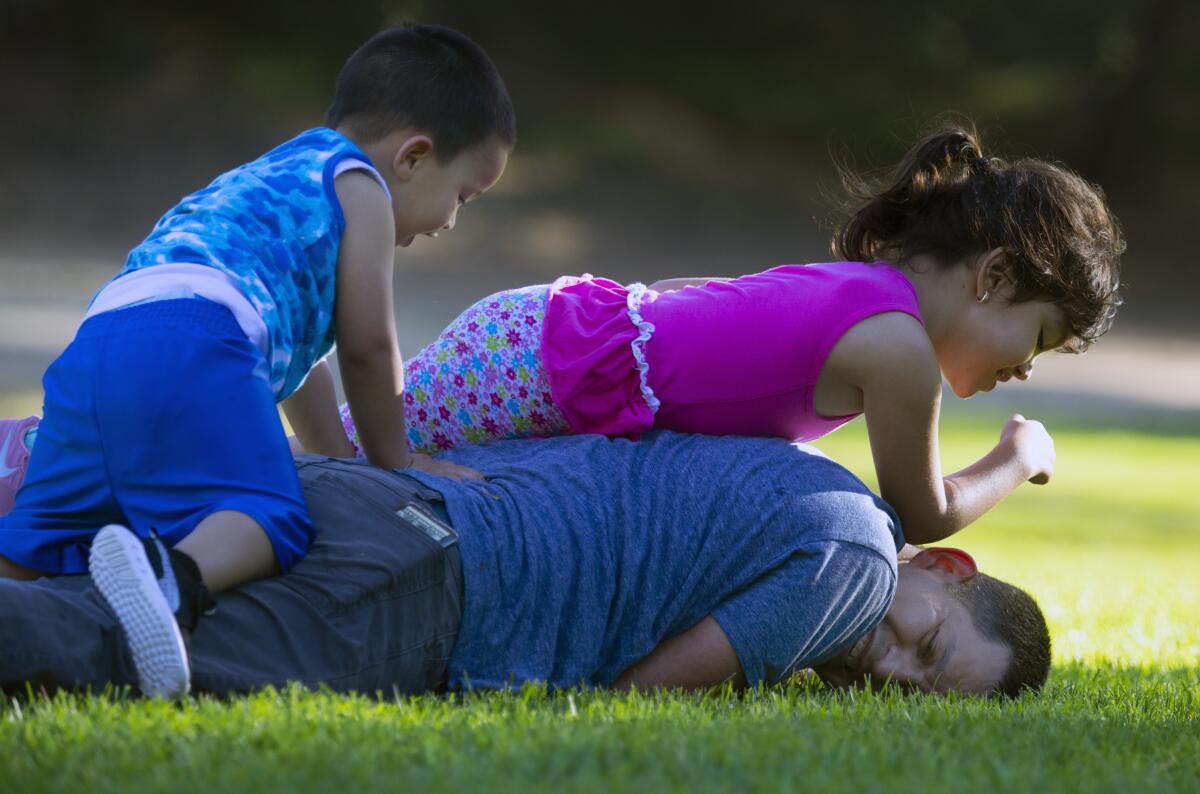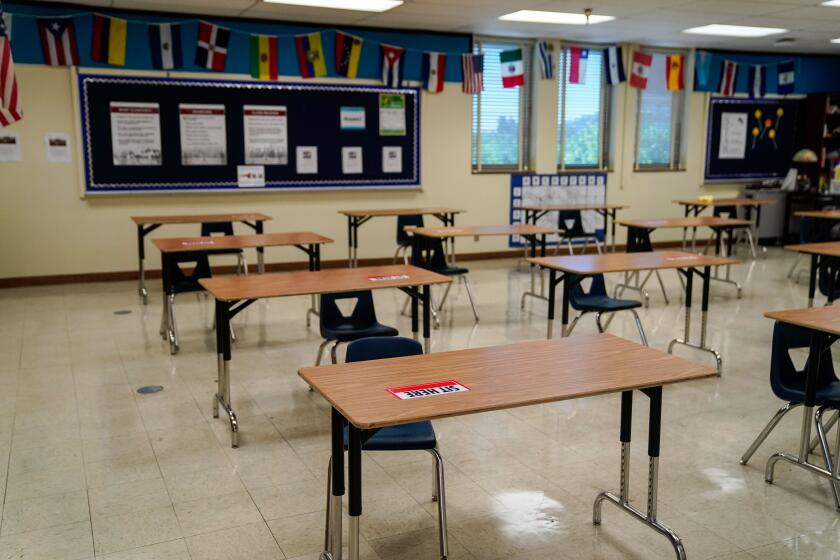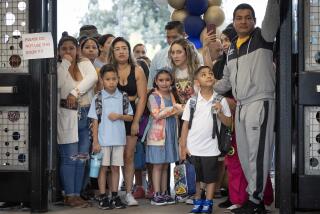Strategies for supporting your child’s social and emotional learning from home

- Share via
Numbers can be multiplied, subtracted and squared in a vacuum, alone in a room. Books, too, on almost any subject, can be processed independently.
Emotions, on the other hand, are typically experienced — and learned — in context, among people, in a social environment.
That’s why some California parents are concerned that virtual learning, mandated in areas that have seen a spike in coronavirus cases, might impede their school-age children’s social and emotional learning. In addition to, or even more, than their academic growth.
Experts agree it’s not something to take lightly.
“For kids, even starting in preschool, social engagement with their peers is so crucial for them to develop a sense of self. And their world,” according to Macy Grim, a psychotherapist who specializes in working with young children.
But there are ways for parents to facilitate their children’s holistic development from home, according to several experts.
“Children will develop socially and emotionally in lots and lots of different contexts. School is not the only way, though it’s an important way, to learn social and emotional skills,” said Justina Schlund, director of field learning at the Collaborative for Academic, Social and Emotional Learning, or CASEL.
The new school year of remote learning will bring unique challenges. Here are guides to help parents of school-age children navigate remote learning, as well as recent updates about education in Southern California.
What is social and emotional learning?
Social and emotional learning encompasses several complex concepts.
It’s a lifelong process “of learning about who you are, including your emotions and your identity, and also how you fit into the larger, broader world,” Schlund said.
She said it’s useful to think about it in terms of five core competencies:
- Self-awareness.
- Self-management.
- Social awareness.
- Responsible decision-making.
- Relationship skills.
It’s key to distinguish it from social and emotional well-being, which is related but distinct, Schlund said.
If the sheer breadth of the concept is stress-inducing, take a deep breath. Like many aspects of our lives during the pandemic, it’s OK to aim for what’s realistic, instead of perfect.
Given the circumstances, it’s possible a child “might not reach what’s seen as typical, but if we see some growth, that is something to be happy about,” said Kahlila Lawrence, an instructor in the University of South Florida’s school psychology program.
Parents’ well-being matters
Learning to manage your own emotional state is crucial, several experts said.
Think about those airplane safety instructions that advise parents to put an oxygen mask on themselves before their children. It’s hard to help someone when you’re gasping for air — literally or metaphorically.
When “parents are anxious and they’re giving off that energy — kids are so sensitive to that, and they’re going to pick up on it,” said Grim, a clinical psychology instructor at Pepperdine University.
Ready, set, reframe: Instead of stressing out about coronavirus and the shutdown, let’s use this time of social isolation to prioritize self-care and mental wellness.
Modeling
Without peers to correct behavior and adults outside the home to model it, parents might have to be more conscientious of their status as role models.
“Parents are constantly teaching their kids, all the time,” Lawrence said. “Now we’re talking about parents who are saying, ‘OK, but how do I engage in more purposeful types of activities?’”
For younger kids, parents can simulate interactions children might have with kids their own age to teach important social concepts, like sharing and learning how to play fair, according to Lawrence. She offered the example of learning to share crayons back and forth. Your child might draw for a bit before you ask if you can hold the crayon — and be sure to say thank you if he or she gives it up graciously.
Checking in
Many teachers across the country start the day with morning meetings, according to Lawrence. “It’s just a way to check in on a regular basis.”
Parents can do the same thing by consistently talking to their kids as a way to make sure they have an outlet to express their fears, frustrations and joys. Schlund said it’s important to build the check-in into a reliable routine. It doesn’t have to be in the morning, but it should come at a similar time of day, she said.
The questions and style will look different based on the age of the child “because the older ones might look at you like, ‘OK, Mom, I told you I’m fine. Leave me alone,’” Lawrence said. Sometimes those conversations will be short.
“Sometimes you might get a little something, like, ‘I’m upset because I can’t see my friends. I’m tired of this,’ and then that can lead to additional conversations,” Lawrence added.
It can also be a place to proactively offer help, Schlund said. In addition to asking children how they are doing, you can ask what they specifically need to make the day a good one.
Stick to a schedule
Experts unanimously underscored the benefits of creating a routine. It creates a sense of normalcy and provides a sense of emotional safety, according to Schlund.
That means no more sleeping at different times each night and spending half of the day in pajamas — things some parents reported happening in spring when distance learning was thrust on their families amid the coronavirus pandemic.
While the pandemic has forced flexibility in many respects, Lawrence stressed, “Kids need routines. That’s very important.”
It will likely help that this fall Los Angeles Unified, the largest school district in the state, will follow a predictable schedule that somewhat mirrors a traditional school day.
Stressors will come; plan ahead
Parents don’t have to wait until their kids are in distress to try to come up with a solution, Schlund said.
Instead, they can think in advance about strategies that their children can work on and practice with them.
Schlund recommends creating a list of things they can do when they feel stressed out, such as going for a run or playing with a sibling. She said this can help children learn effective ways to manage their emotions — a central aspect of social and emotional learning.
Creative ways to connect
Just because your kids might not be able to play soccer with the gang or hug grandma doesn’t mean they can’t maintain relationships in some form.
Screens, the bane of some parents’ existence pre-COVID, can be a gateway to virtual hangouts that allow kids to stay connected to peers and relatives living outside the home. Some parents might consider expanding their quarantine bubble to include another family that is following similar health precautions.
There are also out-of-the-box methods to provide connection. Jesyka Lueck, a psychotherapist from Torrance, said she recently invited a neighbor to read stories to her 4-year-old son, Edison, through a glass window. Edison, who has an underlying medical condition that may make him susceptible to a serious case of COVID-19, has been largely isolated since the spring.
Play as therapy
Grim specializes in a type of child counseling known as play therapy. It’s a means of teaching young children how to recognize, identify, label and regulate their emotions using play.
“If an adult comes into the room and sits on the couch, they can talk about their feelings and their emotions. Kids can’t necessarily do that,” Grim said. “You can never sit a 3-year-old down on a couch and ask them about their feelings. So you use the means of play and metaphors and toys in order to speak their language.”
Parents with enough time and money can learn the basics of play therapy through something called filial therapy, Grim said. Acknowledging that it requires significant privilege to access, she said parents can still learn a lot through books and online resources (see Grim’s recommended reading list below) — which cost a lot less than private therapy and can be tackled any time the parent has a scrap of free time.
Lawrence pointed out the more straightforward decompression benefits of encouraging older children to take breaks during the school day. She said she wouldn’t push a child to work for more than an hour on any one activity.
When to worry
Mood changes, disruptive behavior, attention deficits and some physical complaints (for example, headaches, stomach aches, sleep disturbances) are potential signals that a child is struggling and may require additional support, several experts said.
Individual differences
There are developmental norms to be aware of — children tend to learn social and emotional skills on a certain trajectory or timeline. However, individual circumstances — including parenting styles, socioeconomic factors and a child’s temperament and ability — can have a large impact on social and emotional growth. Some children will inevitably develop faster or slower than what’s typical.
Lean on the experts — educators
You don’t have to go it alone. Lawrence urged parents to reach out to teachers and other education professionals. They can advise generally on what’s developmentally appropriate, as well as potentially provide some more tailored guidance.
Your kids’ teachers love them too, Lawrence said. “They’re resources to help really work and talk through those individual circumstances within your home. And encourage you as well.”
Parents can reach out to learn what social and emotional programs their school already offers and potentially press for more, Schlund said. She added: “It’s really important to advocate and ask for.”
Further reading
Here are some books recommended by child psychotherapist Macy Grim:
- “The Whole Brain Child,” (parents of children ages 3 to 10) by Dan Siegel
- “Brainstorm,” (parents of teens ages 12 and up) by Dan Siegel
- “Siblings Without Rivalry,” by Adele Faber and Elaine Mazlish
- “How to Talk So Kids Will Listen,” by Adele Faber and Elaine Mazlish
- “Positive Parenting,” by Rebecca Eanes
More to Read
Sign up for Essential California
The most important California stories and recommendations in your inbox every morning.
You may occasionally receive promotional content from the Los Angeles Times.












